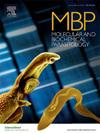Influences of parasitic stress on the health condition of African Catfish (Clarias gariepinus): Biochemical and histopathological alterations
IF 1.5
4区 医学
Q4 BIOCHEMISTRY & MOLECULAR BIOLOGY
引用次数: 0
Abstract
This study investigates the prevalence, severity, and impacts of parasitic infestations in Clarias gariepinus. Additionally, the study assesses the detrimental impacts of parasite infestation on the health condition of affected catfish, focusing on biochemical and histopathological alterations. A total of 160 fish were sampled from local markets. Parasitological examinations involved the dissection of key organs from each fish. The organs were processed and examined microscopically for parasites identified based on morphometric characteristics. Parasitological indices such as prevalence, mean intensity, and abundance were calculated. Fish blood and liver samples were collected to assess hematological and biochemical parameters. Microscopic and ultrastructural examinations identified the gills and liver as highly infected organs, so they were utilized for transmission electron microscopy (TEM). Analysis of catfish tissues unveiled the existence of Cyathocotylid sp. and Prohemistomum vivax, across all organs with dominance noted in the liver, emphasizing their pathogenic significance and notable ability to invade and establish within multiple organs or the immunocompromised response of the host. Meanwhile, Centrocestus formosanus and Quadriacanthus aegyptiacus were exclusively detected in the gills, with an overall parasitic infection rate of 60 %. The present study is one of the few studies documenting Centrocestus sp. in catfish which reflects its ability to spread in new hosts and environments. A novel morphological dimension was recorded for the recovered metacercariae. The hematological, along with the identified lesions from light histological and TEM examinations in heavily infected catfish, indicate the detrimental impact of parasite infiltration on fish health status. Besides the biochemical biomarkers were significantly (p ≤ 0.05) affected by increasing the degree of infection. This study underscores the profound influence of parasitic infestations on the health of C. gariepinus, emphasizing the urgent need for effective management strategies in aquaculture to mitigate these effects, the spread of new pathogens, and ensure the sustainability and productivity of catfish farming. By integrating parasitological, morphological, histopathological, and biochemical analyses, this research provides valuable insights that contribute to better health management strategies in aquaculture and a deeper understanding of parasite biology.
寄生胁迫对非洲鲶鱼健康状况的影响:生化和组织病理学改变。
本研究调查了加里宾Clarias gariepinus寄生虫侵染的流行程度、严重程度和影响。此外,该研究还评估了寄生虫侵染对受感染鲶鱼健康状况的有害影响,重点是生化和组织病理学改变。本署在本港市场共抽取160条鱼样本。寄生虫学检查包括解剖每条鱼的关键器官。对器官进行处理,并在显微镜下检查根据形态特征确定的寄生虫。计算流行率、平均强度、丰度等寄生虫学指标。采集鱼类血液和肝脏样本,评估血液学和生化参数。显微镜和超微结构检查发现鳃和肝脏是高度感染的器官,因此用透射电子显微镜(TEM)观察。对鲶鱼组织的分析揭示了Cyathocotylid sp.和Prohemistomum vivax的存在,在所有器官中都有,在肝脏中有优势,强调了它们的致病意义和在多个器官中入侵和建立的显着能力或宿主的免疫低下反应。同时,在鳃中仅检出台湾Centrocestus formosanus和埃及Quadriacanthus aegyptiacus,总体寄生虫感染率为60%。本研究是为数不多的记录鲶鱼中Centrocestus sp.的研究之一,反映了它在新宿主和新环境中的传播能力。在恢复的囊蚴中记录了一种新的形态维度。血液学,以及在严重感染的鲶鱼的光组织学和透射电镜检查中发现的病变,表明寄生虫渗透对鱼类健康状况的有害影响。此外,随着感染程度的增加,各生化指标均受到显著影响(p≤0.05)。本研究强调了寄生虫侵染对鲶鱼健康的深远影响,强调了迫切需要有效的水产养殖管理策略来减轻这些影响,防止新病原体的传播,确保鲶鱼养殖的可持续性和生产力。通过整合寄生虫学、形态学、组织病理学和生化分析,本研究为水产养殖中更好的健康管理策略和更深入地了解寄生虫生物学提供了有价值的见解。
本文章由计算机程序翻译,如有差异,请以英文原文为准。
求助全文
约1分钟内获得全文
求助全文
来源期刊
CiteScore
2.90
自引率
0.00%
发文量
51
审稿时长
63 days
期刊介绍:
The journal provides a medium for rapid publication of investigations of the molecular biology and biochemistry of parasitic protozoa and helminths and their interactions with both the definitive and intermediate host. The main subject areas covered are:
• the structure, biosynthesis, degradation, properties and function of DNA, RNA, proteins, lipids, carbohydrates and small molecular-weight substances
• intermediary metabolism and bioenergetics
• drug target characterization and the mode of action of antiparasitic drugs
• molecular and biochemical aspects of membrane structure and function
• host-parasite relationships that focus on the parasite, particularly as related to specific parasite molecules.
• analysis of genes and genome structure, function and expression
• analysis of variation in parasite populations relevant to genetic exchange, pathogenesis, drug and vaccine target characterization, and drug resistance.
• parasite protein trafficking, organelle biogenesis, and cellular structure especially with reference to the roles of specific molecules
• parasite programmed cell death, development, and cell division at the molecular level.

 求助内容:
求助内容: 应助结果提醒方式:
应助结果提醒方式:


